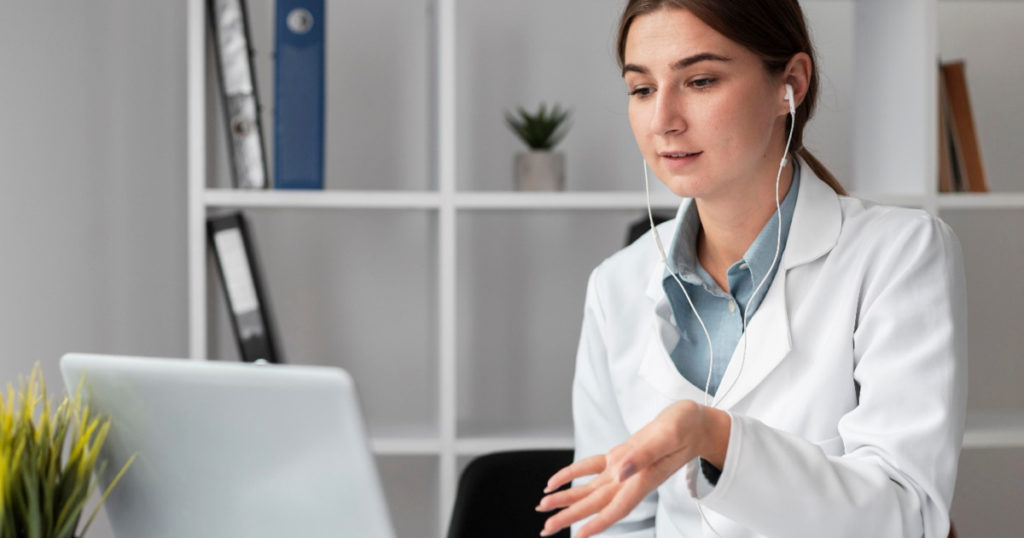Summary
- Telemedicine is an innovative method of delivering healthcare to people at a distance through telephone, internet, video communication, etc.
- Telemedicine for sleep apnea can be used for tele-diagnosis, tele-consultation, tele-monitoring as well as CPAP titration, and education.
- Home (or unattended) polygraphy or polysomnography (PSG) can be used for sleep recording assessment remotely.
- Teleconsultation is an effective method to explain yet undiagnosed or newly diagnosed patients about sleep apnea and its sequels.
- Benefits of sleep telemedicine include easy accessibility, improved quality, and cost-effectiveness.
Telemedicine is a remarkable evolution in the diagnosis and management of patients in the modern-day and age. It has changed the framework of the healthcare industry in the last decade. The integration of smartphones and fast internet connections in our lives paved the way for accessing healthcare services remotely, from our homes and workplaces.
And with the recent advent of the COVID-19 pandemic, the importance of Telemedicine shot to new heights. It is now a crucial component of the healthcare industry and helps medical professionals extend their services even in the most challenging situations.
So, what is Telemedicine?
Telemedicine is an innovative method of delivering healthcare services to patients from a distance. Physicians can evaluate, diagnose, and treat patients remotely through telecommunication medicine. It involves using communication technology like telephone, internet, and video conference to provide primary and secondary care. [1]
How Can Sleep Apnea Be Managed Through Telemedicine?
Telemedicine can be used in various ways for sleep apnea management, including:
Telediagnosis For Sleep Apnea
Home polygraphy or polysomnography (PSG) can be used for sleep recording assessment remotely. It helps patients avoid waiting in long queues for their turn. While PSG is the standard technique for sleep apnea diagnosis, there has been a transition to a less expensive tool called polygraphy to support an increasing number of people developing sleep apnea. [2]
Tele-Consultation After Diagnosis
Teleconsultation is an effective method to explain yet undiagnosed or newly diagnosed patients about sleep apnea and its sequels. It employs the use of the internet and video conferencing for real-time doctor-patient communication.
Teleconsultation can further be used to reinforce and support patients undergoing CPAP treatment remotely. Parikh et al. showed that patient satisfaction levels were similar between patients having face-to-face consultations and those using teleconsultations. [3]
Tele-Monitored Remote Treatment
APAP titration at home, controlled by polygraphy, is a useful alternative to in-lab treatment. It is said to have comparable clinical outcomes for adherence and sleep improvement. However, there are limited studies on this subject, and more extensive trials are warranted.
CPAP Education through Telemedicine
Group patient training sessions can be carried out for sleep apnea awareness through video conferencing. A study has shown that face-to-face sessions and videoconferencing are similar to around 92% outcomes. Thus, teleconsultation is considered a feasible option for sharing essential knowledge among patients for CPAP training. [4]
Source: Wikipedia
Benefits of Telemedicine for Sleep Apnea
- Telemedicine Is Quickly Accessible
Home polygraphy recordings can be made readily available for a quick analysis with the help of TM for data transmission. This is promising, as research shows its failure rate is within 4-12%, allowing easier access to sleep tests in a country with a large population but few specialized sleep centers. [5] - Improved Quality Supervised Assessment
Telemedicine can provide quality polygraphy/PSG performance virtually by constant or intermittent supervision of recording remotely. - Cost-Effectiveness
Two recent studies have demonstrated the cost-effectiveness of Telemedicine in patients treated by CPAP titration in follow up. Both studies found that Telemedicine was less expensive than usual in-lab care compared to 6 months and 3 months, respectively. Other studies supported the cost-effectiveness of Telemedicine for CPAP treated patients. [6],[7]
Bottomline
The application of Telemedicine is helpful in monitoring and motivating patients undergoing sleep management. You can take a sleep apnea test from the comfort of your home at ISD Health Solutions. It’s convenient, affordable, and reliable for clinical results. Book an appointment or call ISD for further details.
References:
- Anonymous. What is Telemedicine? Chiron. https://chironhealth.com/telemedicine/what-is-telemedicine/
- Standards Of Practice Committee Of The American Sleep Disorders Association. Practice Parameters For The Use Of Portable Recording In The Assessment Of Obstructive Sleep Apnea. Sleep 1994; 26: 907–913.https://err.ersjournals.com/content/28/151/180093#ref-12
- Parikh R, Touvelle MN, Wang H, et al. Sleep Telemedicine: Patient Satisfaction And Treatment Adherence. Telemed J E Health 2011; 17: 609–614.
- Isetta V, Leon C, Torres M, et al. Telemedicine-Based Approach For Obstructive Sleep Apnea Management: Building Evidence. Interact J Med Res 2014; 3: e6.
- Borsini E, Blanco M, Bosio M, et al. “Diagnosis Of Sleep Apnea In-Network” Respiratory Polygraphy As A Decentralization Strategy. Sleep Sci 2016; 9: 244–248.
- Isetta V, Negrin MA, Monasterio C, et al. A Bayesian Cost-Effectiveness Analysis Of A Telemedicine-Based Strategy For The Management Of Sleep Apnoea: A Multicentre Randomised Controlled Trial. Thorax 2015; 70: 1054–1561
- Turino C, de Batlle J, Woehrle H, et al. Management Of Continuous Positive Airway Pressure Treatment Compliance Using Telemonitoring In Obstructive Sleep Apnoea. Eur Respir J 2017; 49: 1601128.


